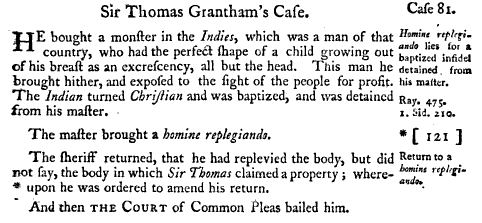The Case of Sir Thomas Grantham’s Monster
Posted by Ryan on April 12th, 2011Imagine you were far away from home and you found a monster. Not a metaphor, but a genuine, grotesque oddity.
What would you do with it?
I have in my possession a copy of Modern Reports: Or Select Cases, Adjudged In The Courts Of King’s Bench, Chancery, Common Pleas And Exchequer. Volume The Third, printed in Dublin in the year 1794. Thanks to the magic of the internet, you can read along at home. This volume includes:
“A Collection of several Special Cases adjudged in the Court of King Bench in the last Years of the Reign of Charles the Second in the Reign of King James the Second and in the first and second Years of King William and Queen Mary. Together with the Resolutions and Judgments thereupon.”
Don’t worry; this is not an English history lesson, all you need to know from this paragraph is that this book covers legals cases from roughly the 1680’s – 1691. While doing some research I came across Case 81: Sir Thomas Grantham’s Case. But, before we get into the details of the case – who was Sir Thomas Grantham?
Sir Thomas Grantham was your typical bad-ass 17th century British naval commander. He was an English tobacco trader and naval officer, commander of the naval fleet of the British East India Company. In 1676 he helped put down Bacon’s Rebellion in Virginia, and in 1684 he put down another insurrection in Bombay. He helped build forts and was made Admiral and knighted by King Charles II. Oh yeah, and he wrote a book about his adventures called An Historical Account of Some Memorable Actions, Particularly in Virginia; Also Against the Admiral of Algier, and in the East Indies: Perform’d for the Service of his Prince and Country. Also available due to the magic of the internet!
If an “s” looking like an “f” makes you want to punch something, here is the modern “translation”.
Sir Thomas Grantham’s Case
He bought a monster in the Indies, which was a man of that country, who had the perfect shape of a child growing out of his breast as an excrescency, all but the head. This man he brought hither, and exposed to the sight of the people for profit. The Indian turned Christian and was baptized, and was detained from his master.The master brought a homine replegiando.
The sheriff returned, that he had replevied the body, but did not say, the body in which Sir Thomas claimed a property; where-upon he was ordered to amend his return.
And then the Court of Common Pleas bailed him
Enough history and legal jargon; what does this actually mean? Well apparently old Sir Thomas was travelling around the East Indies, trading and putting down rebellions, when he came across a man with a perfectly formed child’s body growing out of his chest – minus the head. I am having a hard time visualizing this. Did it have arms and legs? I am having strong Quato flashbacks right now. Sir Thomas decided to supplement his Admiral’s income and start his own private one-show circus around England.
Then one day, the man converted to christianity and was baptized, and Sir Thomas had him taken away. It doesn’t really say who took away the man, but I am thinking that there is a connection between the conversion and the taking. Not to be outdone, Grantham dropped a writ of de homine replegiando in the court. Homine replegiando is latin for “replevying of a man” and was used to regain possession of property, goods, or services wrongfully taken or detained; it was also regularly used to protect parental rights. The sheriff replieved the man and then the Court of Common Pleas bailed him out from custody of the sheriff and returned him to Sir Thomas Grantham.
I should note that my knowledge of English common law is limited to what Google can tell me, so I may be interpreting this passage completely wrong. However, it seems to me that Sir Grantham got his “monster” back and I can only imagine that he continued his circus act around the country.
